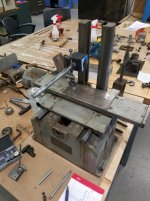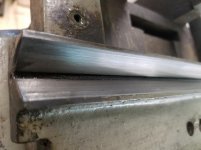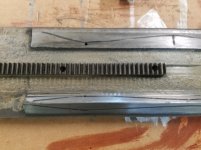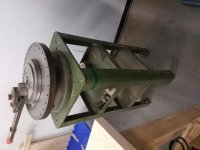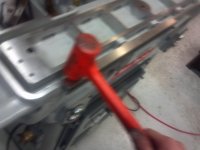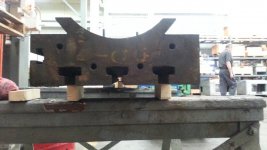twalsh341
Aluminum
- Joined
- Nov 12, 2008
- Location
- Philadelphia, PA
Hello Everyone,
I picked up one of those tiny Sanford grinders recently and I've got it almost completely apart. I've got a small list of parts to make, and new gears to fit. Fortunately a lot of these parts can be had off the shelf and modified to fit.
Today I cleaned up the ways with solvent and inspected the travel of the table with an indicator on a mag base on the column. I have a slope towards the rear of the cross travel of -.014" and a slope towards the left hand side of the machine travel of -.003". I inspected the v ways in vee blocks and they have some wear to the 90 degree v, but are straight to about .001", meaning most of the wear has to be on the carriage.
There is wear on the column too, but I haven't inspected yet. The spindle feels smooth, and doesn't have a lot of end play, I haven't inspected that yet either, but I'm hopeful that it'll be in pretty good shape.
I have done a little bit of scraping to get two flat things into mating contact, but the complexity of all these surfaces is a lot to wrap my hear around. I'm reading through "Machine Tool Reconditioning" to try to work out a plan of attack.
I feel capable of scraping the column ways into alignment and square to the base,but the next step after that is to scrape the v ways, which I'm pretty intimidated by. I think I need to make a 90 degree gauge block, with the vee 45 degrees to a flat that I can indicate to ensure that the V is aligned properly. Since these v ways are removable, with locator pins, and measure only .765"x.765"x 8.00" does it make sense to send the vee ways to someone with a tight surface grinder to grind these, then use them to spot and scrape the carriage? Then put my big boy pants on and tackle the vee/flat of the table with the scraper?
Thanks!
I picked up one of those tiny Sanford grinders recently and I've got it almost completely apart. I've got a small list of parts to make, and new gears to fit. Fortunately a lot of these parts can be had off the shelf and modified to fit.
Today I cleaned up the ways with solvent and inspected the travel of the table with an indicator on a mag base on the column. I have a slope towards the rear of the cross travel of -.014" and a slope towards the left hand side of the machine travel of -.003". I inspected the v ways in vee blocks and they have some wear to the 90 degree v, but are straight to about .001", meaning most of the wear has to be on the carriage.
There is wear on the column too, but I haven't inspected yet. The spindle feels smooth, and doesn't have a lot of end play, I haven't inspected that yet either, but I'm hopeful that it'll be in pretty good shape.
I have done a little bit of scraping to get two flat things into mating contact, but the complexity of all these surfaces is a lot to wrap my hear around. I'm reading through "Machine Tool Reconditioning" to try to work out a plan of attack.
I feel capable of scraping the column ways into alignment and square to the base,but the next step after that is to scrape the v ways, which I'm pretty intimidated by. I think I need to make a 90 degree gauge block, with the vee 45 degrees to a flat that I can indicate to ensure that the V is aligned properly. Since these v ways are removable, with locator pins, and measure only .765"x.765"x 8.00" does it make sense to send the vee ways to someone with a tight surface grinder to grind these, then use them to spot and scrape the carriage? Then put my big boy pants on and tackle the vee/flat of the table with the scraper?
Thanks!


